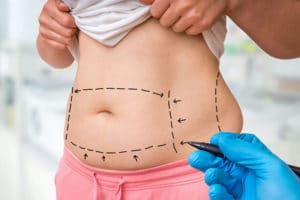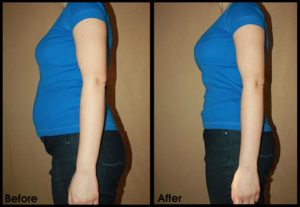What is this procedure?

This is also known as a ‘tummy tuck’. It is another popular procedure and involves the removal of excess skin and fat from the waist which cannot be shifted by diet and exercise alone. In this guide both the terms abdominoplasty and tummy tuck surgery are used, they both are one and the same procedure. Some clinics prefer to call it abdominoplasty but most of the general public will know of the procedure as a tummy tuck.
There are three types of abdominoplasty: Complete abdominoplasty, Partial or ‘mini’ abdominoplasty, Extended abdominoplasty
Abdominoplasty, or tummy tuck, is a cosmetic surgical procedure that helps flatten the abdomen by removing excess fat and skin. It also tightens the muscle. The best candidates for an abdominoplasty are non-smokers who are in good physical condition and at a stable weight. They will also have pockets of fat or loose skin that has not responded well to diet and exercise. Abdominoplasty is an appropriate procedure for slightly obese people who have lost elasticity in their skin and for women whose skin and muscles have been stretched from pregnancy. Women who are planning to have more children or anyone planning on losing a significant amount of weight should wait before undergoing an abdominoplasty. Many patients undergo an abdominoplasty after pregnancy or bariatric surgery.
A partial abdominoplasty, or mini-tummy tuck, is a less invasive procedure with shorter incisions. It is ideal for those patients with fat localized in the lower part of the abdomen. The procedure produces less scarring and a shorter recovery time.
Who needs this procedure?
If you are in good health, emotionally stable and have realistic expectations about this surgery then you will be considered to be a good candidate. It helps if you follow a healthy eating and exercise regime as you will need to continue this to ensure that you retain that flatter, tighter abdomen. Women who have recently had a baby find this surgery useful as it can tighten loose skin which has stretched as a result of their pregnancy. It can also benefit older patients who notice that the skin around their midriff has lost some elasticity. It can also remove excess fat gained as a result of a slowing down of the metabolism. If you are carrying a fair degree of weight then you will be advised to lose that before being considered for surgery. As with any type of cosmetic surgery your suitability will be carefully assessed during your consultation with a surgeon. Both men and women are suitable for this procedure.
In general, you may be a good tummy tuck candidate if: You are physically healthy and at a stable weight, You have realistic expectations, You are a nonsmoker, You are bothered by the appearance of your abdomen.
A Tummy Tuck for Loose Skin: It’s common for skin of the stomach to stretch during pregnancy or when you’ve gained a significant amount of weight. Unfortunately, oftentimes after you’ve had the baby or dropped the pounds, the abdominal skin just doesn’t bounce back. Instead, it may appear to be permanently stretched out and resistant to change, no matter how many crunches you complete or how much weight lifting you do. If your skin simply refuses to go back to its original shape, it may mean it’s time for a tummy tuck.
Abdominal Crease: Do you have an abdominal crease? If so, a tummy tuck may help. An abdominal crease is simply a fold in the stomach skin that appears as a result of excess skin on either side of the fold.
Belly Overhang: Belly overhang occurs when the skin of the abdomen hangs down. The skin may end up covering the top portion of a person’s underwear or pants. It is colloquially known as a muffin top. This look is unsightly enough that it drives many people to seek out a tummy tuck.
Frowning Belly Button: A belly button normally takes on a circular or oval shape. If the belly button appears to be “frowning,” it can be an indicator of loose or excess skin and fat. If you want to expose your stomach on the beach or while exercising and feel self-conscious about your navel, a tummy tuck may help.
Wrinkled Skin: Skin that has been stretched out and has not returned to its original form may be crinkled or wrinkled in appearance.
Double-Bubble: If you have two bulges of skin, usually one above the belly button and one below, this can signal that your skin is indeed loose and excessive. Consider a tuck to get rid of the extra skin.
What is the advantage of this procedure?
 You will have a firmer, toned and flatter abdomen. If you had some lower abdominal bulge as a result of pregnancy then this will have disappeared. This also includes stretch marks! Your waist will appear slimmer and this tighter, youthful abdomen will boost your confidence and self-esteem. You will have a firmer, toned and flatter abdomen. If you had some lower abdominal bulge as a result of pregnancy then this will have disappeared. This also includes stretch marks! Your waist will appear slimmer and this tighter, youthful abdomen will boost your confidence and self-esteem.
You will have a firmer, toned and flatter abdomen. If you had some lower abdominal bulge as a result of pregnancy then this will have disappeared. This also includes stretch marks! Your waist will appear slimmer and this tighter, youthful abdomen will boost your confidence and self-esteem. You will have a firmer, toned and flatter abdomen. If you had some lower abdominal bulge as a result of pregnancy then this will have disappeared. This also includes stretch marks! Your waist will appear slimmer and this tighter, youthful abdomen will boost your confidence and self-esteem.
Easier to Maintain Weight Loss: people who go under the knife to reduce the size of the stomach in an effort to lose weight — were more likely to keep the weight off post-surgery when they combined it with a tummy tuck. In fact, patients that combined the two procedures regained an average of only a pound a year as opposed to 4 lbs a year for bariatric patients that didn’t have any body-contouring procedures performed.
Improved Posture
Carrying an apron of excess skin combined with weakened abdominal muscles can lead to a condition called lordosis , commonly known as “sway back”. This is sometimes accompanied by at least some back pain.
Since a tummy tuck will strengthen and tighten the abdominal muscles, the spine becomes supported, and the patient can stand up a little bit straighter. Any back pain that may have been caused by the previous condition should also be diminished or alleviated entirely.
No More Stress Urinary Incontinence
Women who undergo vaginal birth sometimes develop stress urinary incontinence or SUI. This is where the bladder tends to empty itself at awkward times, usually when coughing, sneezing, laughing or exercising.
Relief from Hernias
Ventral hernias can develop when the abdominal muscles become weak. In some cases, hernias can follow a Caesarean section or appendectomy. A ventral hernia is where the intestine or abdominal tissue begins to push through the abdominal wall. The plastic surgeon can also help this condition during the tummy tuck procedure. The combined procedures are safe, practical, and can save the patient money on medical expenses, as well as on the time spent in recovery.
Increased Exercise Tolerance:
Excess skin and weak abs can make it difficult to exercise. A tummy tuck can reinvigorate the patient’s love of running, walking, or other aerobic activities. It is well-known that exercise is great for the heart and a person’s general well-being. Frequent exercise can also help to retain weight loss.
Are there non-surgical treatments?
Unfortunately, there are no non-surgical treatments that can be considered a viable alternative to a tummy tuck. You might have heard of some non-surgical options such as Cool Sculpting, which eliminates fat cells by freezing them, and various laser treatments, which can be used to tighten slightly loose skin.
While Cool Sculpting and laser skin treatments can deliver limited amounts of skin tightening and a small amount of non-surgical fat reduction, these so-called “tummy tuck alternatives” cannot remove excess skin or tighten the abdominal muscles like a traditional tummy tuck. We have had great success with tummy tuck surgery and the results have been positive and life changing for many of our patients. If you are a good candidate for a tummy tuck with a significant amount of loose skin, abdominoplasty is by far the most effective treatment option. No non-invasive procedures of any kind can remove loose skin or excess fat in the abdominal area at anywhere near the level of a tummy tuck.
What is the surgical treatment like local or sedation?
During the abdominoplasty procedure, the patient is placed under general anesthesia. Two incisions will be made: one from the hip bone on one side to the hipbone on the other side of the body, close to the pubic area, the other incision around the navel. The skin will be separated from the abdominal muscles. The abdominal muscles are then pulled together and stitched into place for a more narrowed waist and firmer abdomen. The separated flap of skin is then stretched over the newly tightened muscles and excess skin is removed. The navel is reattached to a position where it looks natural. The incisions are closed and a sterile dressing is applied over the area. The abdominoplasty procedure can take from two to five hours to perform.
Normally, general anesthesia is required for a tummy tuck surgery. An abdominoplasty is a reasonably large surgery requiring extensive dissection, muscle tightening, and large amount of skin removal. The patient must be kept from moving on the operating room table and complete surgical control is vital. The layer over the rectus muscle called the fascia is tightened in the midline as well. We have performed hundreds of tummy tucks under general anesthesia with safe and predictable results.
What is the recovery like?
 A temporary tube may be inserted under the skin to drain excess fluid from the surgical site. A compression garment is worn during the recovery period. Recovery can vary from two weeks to two months. During this time patients should avoid strenuous activity and avoid lifting heavy objects. With their doctor’s permission, the patient may return to work after a week or two. You’ll wear an abdominal binder for about six weeks. This helps to avoid fluid buildup and helps to support your abdomen. While the recovery period is usually shorter for a mini-tummy tuck, you’ll still need to avoid strenuous activity for at least six weeks. This includes any vigorous exercise or heavy lifting.
A temporary tube may be inserted under the skin to drain excess fluid from the surgical site. A compression garment is worn during the recovery period. Recovery can vary from two weeks to two months. During this time patients should avoid strenuous activity and avoid lifting heavy objects. With their doctor’s permission, the patient may return to work after a week or two. You’ll wear an abdominal binder for about six weeks. This helps to avoid fluid buildup and helps to support your abdomen. While the recovery period is usually shorter for a mini-tummy tuck, you’ll still need to avoid strenuous activity for at least six weeks. This includes any vigorous exercise or heavy lifting.
How long does it take?
When you get up, have a shower but do not put any make up on. Do a last minute check around the house and then have someone drive you to the hospital or clinic. When you arrive at the clinic or hospital you will have to go through a standard admissions procedure. This is purely routine and involves you filling in some forms with details of your name, address, age, next of kin etc. If you have not already paid for your surgery then a hospital cashier will settle that with you. Most people prefer to settle the payment before they have their surgery. Once you done all this you will be taken to your room and helped to settle in. The medical staff will help you to unpack and put your things away. They are also there to reassure you.
A nurse will come and see you to undertake a series of pre-surgery checks. These include taking a blood and urine sample, taking your blood pressure and measuring your height and weight. He or she will also give you a pair of compression stockings to change into. These stockings are designed to prevent the build up of blood clots in the legs which can be dangerous. Blood thinning medicines such as Heparin can also protect against this. You will have a visit from your surgeon. He or she is there to put your mind at ease and answer any last minute questions that you may have. If you have not already done so then you will be given a consent form to sign. This is what they term ‘informed consent’ and is a statement to the effect that you understand what the procedure is and what the risks are.
Take plenty of time reading through this and if you see anything you don’t understand then ask. Once you are happy with everything in this form then sign it and pass it back to your surgeon. The length of your procedure and the type of anesthesia you have depends on whether you are undergoing a full, partial or extended abdominoplasty.
How long has it been around?
The tummy tuck procedure, also known as abdominoplasty, was originally developed over 100 years ago. Although this may seem like a long time, the technique is actually relatively new considering that plastic surgery has been practiced for thousands of years, spreading from the ancient cultures of India through the Middle East and Egypt to the empires of Greece and Rome.
Being a somewhat novel surgical technique, abdominoplasty has undergone a number of changes over the past century. This process of improvement and refinement continues today as surgeons strive to produce the best possible results for their patients. Read on to learn some tummy tuck facts: the origins and development of the tummy tuck and how it became the hugely popular procedure it is today.
Origins
Like many plastic surgery techniques, abdominoplasty was originally developed for medical purposes. Surgeons treating umbilical hernias (protrusion of the belly button) sometimes encountered patients where the protruding umbilicus was associated with an excess of abdominal skin and fat. In the first “dermolipectomies” during the 1890’s, French surgeons removed patients’ excess skin to improve access to the herniated tissue and found the procedure also led to a rapid and immediate improvement in their body contour.
The procedure spread quickly to the United States, where the first tummy tuck was performed in Maryland in 1899. It did not take long for both patients and doctors to recognize the aesthetic benefits of this procedure, leading to rapid improvements in abdominoplasty as a purely cosmetic surgery.
Early Improvements
One major cosmetic issue with the earliest approaches is that the belly button was removed, leaving behind an unnatural looking abdomen. French and German surgeons separately developed solutions for this problem in 1905 and 1909, respectively, using alternative incision locations to avoid damaging the outward appearance of the belly button. Later advances in the 1920s managed to preserve the internal structures of the umbilicus as well.
War Brings Rapid Advancements
While the overall appearance of the abdomen could be improved, the procedures’ cosmetic results were still less than ideal. Scarring was a significant issue, and it was difficult to preserve the results, as the optimal incision sites and suture styles had not yet been determined. The huge increase in the need for reconstructive surgery of the abdomen during the World Wars, however, brought rapid improvements in the kinds of techniques used in abdominoplasty. This created a wealth of medical knowledge that improved results and paved the way for the procedure’s rapid growth in popularity.
Modern Refinements
From the perspective of cosmetic surgeons, the most important advances in abdominoplasty have occurred in the last 30-40 years. During this period, suturing techniques have improved dramatically. Surgeons working throughout the 1960s and 1970s, for instance, identified approaches that both minimized the appearance of the scars and allowed significant improvements to body contour. Later, in 1988, the decision to integrate liposuction into the procedure dramatically increased the ability of surgeons to customize abdominoplasty to different body types. Most recently, in the mid-1990’s, an approach for suturing the abdomen was discovered that drastically reduced distortion of the tissues, improved healing time, and maximized contouring results. The development of these techniques have turned the tummy tuck into the safe and effective procedure it is today.
What are the complications?

This is a highly popular and safe procedure. When performed by an experienced, professional surgeon then it generally works well and gives great results. Nevertheless, there are risks with all types of surgery. There are complications which can happen to any surgical procedure and these include infection, bleeding, hematoma, adverse reaction to anesthesia and scarring. Every procedure has risks which are specific to that procedure. In the case of abdominoplasty these are:
- Numbness to the thighs or abdomen: This can happen if there has been nerve damage during surgery. It tends to happen below the navel and is usually temporary. Sensation will return but can leave a small area permanently without sensation
- Skin or fat necrosis: This is where tissue alongside the abdominal incision dies. This can happen if it has been an extensive abdominoplasty. Necrosis can delay healing tends to be more of a problem in those patients who smoke.
- Hematoma: This can occur if blood is not drained via the drainage tubes and collects under the skin. It can form a blood volt in this case. If this happens then the patient will require further surgery to drain this and stop any further bleeding.
Along with the usual risks associated with surgery and anesthesia, the risks of an abdominoplasty include the following: Asymmetry, Scarring, Loose skin, Numbness in the skin, poor results. Patients who have had previous abdominal surgery may find that their scars are raised, stretched or are more noticeable. A scar revision may address their concerns and minimize the results.
What can you do to speed up recovery?
Your recovery will be carefully monitored in a recovery unit. Once the medical staff is satisfied with your recovery then they will arrange for you to be taken back to your room. Back in your room a nurse will check your dressings and your condition in general. You may be given an injection of a blood thinning agent to stop the build up of any blood clots. These can form as a result of long periods of inactivity.
You can expect your abdomen to be sore and swollen for the first few days but you will be given pain medication to deal with this. You will also be given an ample supply of these when you go home.
You may also be given pillows to put behind your knees when you are lying in bed. This is to help reduce any strain on your abdominal muscles.
The support girdle will have to be worn for at least six weeks. You will find it difficult to stand up straight but you will be encouraged to get up and start walking around as soon as you are physically able to do so. This is to prevent the risk of blood clots and deep vein thrombosis. Your stitches will be the dissolvable type so you do not need to have these removed although you will need to attend the clinic or hospital for follow up visits.
After a couple of days you will be able to go home. Your surgeon will check that you are well enough to do so and will advise you on showering and taking care of your dressings. He/she will also advise you on what to do when you get home which means taking things easy for the first few days. Do not overtax yourself or put any strain on your surgical wounds. He or she will also give you the date of your first aftercare visit. Once this is done, you will be discharged from hospital.
Do you need to rest up afterwards and for how many days?
After a tummy tuck, your abdominal incision and bellybutton will likely be covered with surgical dressing. Small tubes might be placed along the incision site to drain any excess blood or fluid.
Members of your health care team will help you walk as early as the first day after a tummy tuck to help prevent the formation of blood clots.
You’ll likely feel moderate pain, which will be controlled by pain medication. It’s normal to have swelling in the surgical area.
Drains might be left in place for several days after surgery. Your doctor or another member of your health care team will show you how to empty and care for your drains. You might need to continue taking an antibiotic as long as the drains are in place.
Your surgeon might also prescribe a blood-thinning medication for a short time after your tummy tuck.
You’ll wear a supportive abdominal garment (abdominal binder) for about six weeks after your tummy tuck. This helps prevent fluid buildup and provides abdominal support while you heal. Your doctor will explain how to care for your scar.
For the first six weeks after a tummy tuck, you’ll need to be careful when moving around. You’ll also need to avoid positions that strain your incision line — such as quickly bending at the waist — to prevent the reopening of the wound.
Before & After Gallery

